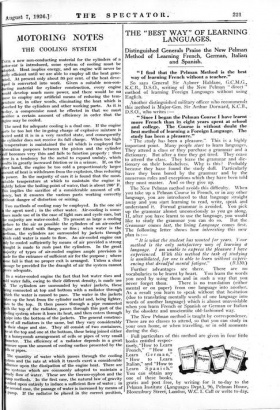MOTORING NOTES
THE COOLING- SYSTEM
sm. a new non-conducting material for the cylinders of a tor-car is introduced, some system of cooling must be opted. Heat implies energy, and an engine will never be
efficient until we are able to employ all the heat gene- ted,. At present, only about 30 per cent. of the heat deve- ped is converted into work. Given a suitable non-con- ding material for cylinder construction, every engine ould develop ranch more power, and there would be no use to employ any artificial means of reducing the' tern- rature or, in other words, eliminating the heat which is sorbed by the cylinders and other working parts. As it is -day, a compromise must be effected in that we must orifice a certain amount of efficiency in order that the gine may be cooled.
The need for adequate cooling is a dual one. If the engine p.qts be too hot the in-going charge of explosive mixture is heated ted until it is in a very rarefied state, and consequently e cylinder does not receive its full charge. When too high temperature is maintained the oil which is employed for brication purposes between the piston and the cylinder II becomes very thin and fails to function properly ; thus ere is a tendency for the metal to expand unduly, which ults in greatly increased friction or in a seizure. If, on the her hand, the engine be too cold a proportionately larger count of heat is withdrawn from the explosion, thus reducing power. In the majority of cars it is found that the most. itable temperature at which to maintain the engine is ghtly below the boiling-point of water, that is about 200° F- s implies the sacrifice of a considerable amount of effi ney, but it ensures the various parts working correctly lhout danger of distortion or seizing.
Two methods of cooling may be employed. In the one air is the agent used ; in the other water. Air-cooling is some- times made use of in the case of light cars and cycle cars, but e majority are water-cooled. To present as large a cooling rface to the air as possible the cylinders of an air-cooled gine are fitted with flanges or fins ; when water is the edium, the cylinders arc surrounded by jackets through sich cold water is made to flow. An air-cooled engine can ly be cooled sufficiently by means of air provided a strong aught is made to rush past the cylinders. In the great jority of types of air-cooled engines ample provision is ade for the entrance of sufficient air for the purpose ; where me fail is that no proper exit is arranged. Unless a clear ssage be provided for the draught of air the system cannot ye adequate.
In a water-cooled engine the fact that hot water rises and Id water falls, owing to their different density, is made use
The cylinders are surrounded by water jackets, these ing connected at top and bottom with a radiator through hich the water is caused to pass. The water in the jackets kes up the heat from the cylinder metal and, being lighter, to the top. It then passes through a pipe connected th the top of the radiator, passes through this part of the • ling system where it loses its heat, and then enters through pipe into the bottom of the jackets. The general construc- t' of all radiators is the same, but they vary considerably their shape and size. They all consist of two containers, eat the top and one at the bottom, these being joined either ,a honeycomb arrangement of cells or pipes of very small. meter. The efficiency of a radiator depends in a great ure upon'the amount of cooling surface presented by the Is or pipes.
The quintity of water which passes through the cooling stem and the rate at which it travels exert 'a considerable uenee upon the dissipation of the engine heat. There are systems which are commonly adopted to. maintain a y flow of water. These are the thernio-syphon and the P methods.. In the first case, the natural law 'of. gravity relied upon entirely to induce a sufficient flow of water ; in second case, the passage of water is increased by means of Pump. If the radiator be placed in the correct position,
".% I
with the top container above the top and the bottom container below the bottom of the water jackets, this system works excellently and is quite equal to the pump method. The chief advantages of the thermo-syphonic method are that there is no pump to get out of order, and the circulation of water pro- ceeds in direct proportion to the heat of the engine. It may be said, therefore, to be perfectly automatic. In cold weather the flow is slower ; in hot weather or when the engine is working under a heavy load, the flow is more rapid. An approximately even engine temperature is therefore always maintained. When the pump_ system is employed a small pump, worked off the engine, is fitted ; this forces the water from the bottom of the radiator into the jackets ; thence to the top of the radiator. The advantage of this system is that a smaller quantity of water may be carried—this means that a smaller radiator may be fitted—as the speed of flow is greater.
The passage of air through the radiator, that is between the cells or the grilled tubes, is assisted by a rapidly revolving fan which is attached to the front of the cylinder block and placed directly behind the radiator. The fan is driven by a belt working on a pulley attached to the engine crankshaft. The correct working of the fan is essential to the efficient working of the cooling system as a whole.







































 Previous page
Previous page